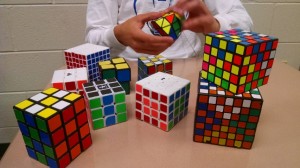LZHS’ puzzle masterminds
 The fastest time anybody has ever solved a Rubik’s cube is 5.55 seconds.
The fastest time anybody has ever solved a Rubik’s cube is 5.55 seconds.
In the same amount of time, the average person could walk five to ten feet, or could brush one and a half teeth, if they brush for the prescribes two minutes. But it only takes some people that time to solve a standard, three by three Rubik’s Cube, even though there are approximately forty-three quintillion possible solutions, according to Wikipedia.
Solving a Rubik’s Cube is performed through a series of algorithms, or patterns, which tell you when and how to turn the Rubik’s Cube, as well as what order to turn the cube in, according to Troy Mundschenk, sophomore who frequently uses Rubik’s Cubes.
“I was on my way to Cleveland [Ohio] for a band trip and one of the [saxophone] people in the band was doing a Rubik’s cube, and I was very interested in the process. I asked him if he would teach me,” Mundschenk said.
Learning how to use the Rubik’s cube took four hours, but in order to fully master the Rubik’s Cubes, it took weeks of practice, according to Mundschenk.
“The five by five cube is the hardest, but it’s about the design of the cubes. Picture cubes usually are the hardest,” said Mundschenk, “not only does everything have to be in the right place, but everything has to be facing the right direction.”
Rubik’s cubes have different sizes, such as a five-by-five, or even a two-by-two rubik’s cube. Picture Rubik’s Cubes have a piece of artwork on each square, instead of just one solid color, creating the issue of having every cube facing the same way, as well as in the correct place. There are multiple types of sizes of Rubik’s Cubes as well.
“My hardest Rubik’s Cube would probably have to be my three by three by five cube, which has six sides,” said Stevens, “what makes this one harder to solve is that it shape shifts. With one side being a different size, once you twist it, it doesn’t match up.”
The cube is also harder to solve because of the wide variety of incorrect scrambles and the complicated shape, according to Stevens.
Rubik’s Cubes are also a form of group entertainment for Stevens and Mundschenk.
“I’ll put the cube in a pattern, like a series of stripes, or polka dots or something like that and then see if [my friends] can undo it,” said Mundschenk.
Solving Rubik’s Cubes can be beneficial in more than just competitions, according to Andrea Collins, AP Psychology teacher.
“Any type of puzzle will help students develop their divergent thinking skills. Divergent thinking is just when you think of multiple ways to solve a problem,” Andrea Collins said.
Students who use a Rubik’s cube or other type of puzzle regularly have noticed an increase in abilities as well.
“[Solving Rubik’s Cubes] has definitely helped with my reaction time,” said Stevens, “I can respond to things a lot faster now. For example, in football, I’m a running back, so sometimes I have to make quick decisions; cut one way or another. Doing Rubik’s Cubes requires split second decisions like that, so it helps.”
